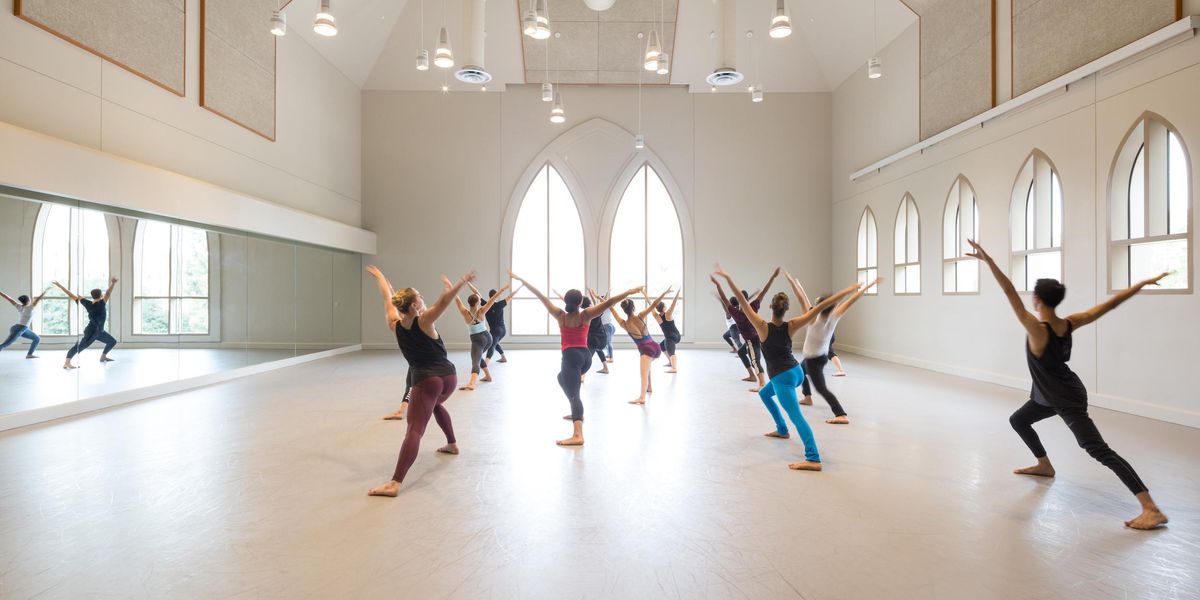Making It Happen: A Dance-Life Continuum Rooted in Hip-Hop
A Dance-Life Continuum, Rooted in Hip-Hop
D. Sabela Grimes leads a Funkamentals class at UCLA.
On the second floor of Glorya Kaufman Hall, nine UCLA students gather in a circle to engage in what professor D. Sabela Grimes calls “cipher-building.” A cipher is a central site of performance and battle for street dancers, but Grimes chooses to tap the cipher for alternative purposes. The group of young black, white, Latino, and Asian men and women toss around questions about race, culture, gender, and identity. One Latina wonders why black women look at her funny when she walks into a party of mostly black people. She follows her thought by asking why black men like to date white women. A black man with Caribbean roots shares how amused he is when people are surprised he speaks Spanish.
Welcome to Grimes’ Hip-Hop Funkamentals Movement Experience. It’s not a class where you’ll find choreographed eight-count combinations or catty competition. Instead, Grimes’ syllabus covers myriad ideas which all circle back to identity exploration. He begins and ends each class in a cipher.
“The cipher is a great place to challenge the ways we generalize about each other, see each other,” says Grimes, “to challenge notions of race, masculinity, femininity.”
Grimes constantly wrestles with how to teach a culture like hip-hop. It’s why he developed this course. “It’s an experience more than a technique,” he says. “I use dance as a gateway to talk about Afro-Diasporic cultural product and history, and the body.”
In Grimes’ world, dancing and living are part of a circular give-and-take. By being present in our bodies and aware of how we take up space, he believes, we start to see how life can be a dance. Pushing at the borders of a traditional understanding of dance, he does not restrict his definition to what is performed on a stage or practiced in a room. Dance already exists inside the body, and it releases itself daily at different moments. Funkamentals goes about uncovering these organic rhythms.
Grimes comes from the schools of street and party dancing. He joined Rennie Harris Puremovement in 1997 and was soon made the company’s director of education and outreach. Teaching workshops around the world, Grimes observed that the way dancers learned on the streets—through communities that shared ideas and information—was not happening in the studio. He wanted to tap into what he knew best. He wanted to teach people how to get in the groove.
In 2006, while completing his MFA in dance/choreography at UCLA in the World Arts and Culture Department, Grimes was asked to bring his Funkamentals Movement Experience to UCLA. Since most of the students in his class were not primarily hip-hop dancers, one of Grimes’ challenges was learning to deal with people who were expecting to learn studio hip-hop.
During his class, students concentrate on isolations, or Funkamental Isos. Grimes focuses on the building blocks of movement, sometimes ordering several Isos in succession. Necks slide forward and back, then rib cages circle 360 degrees, followed by feet stepping one at a time in a quarter turn until the student has made a complete revolution. The same sequence is repeated again and again. “When we do Isos, it’s a meditation,” says Grimes. “Every minor movement creates an intention for you to learn something new about yourself. It’s whole-body listening.”
Back in the studio, a half hour has passed since class officially ended. Grimes’ students remain in the shape of the sun. The inquisitive minds continue their conversation, using hip-hop as a springboard to discuss issues of race, gender, politics, culture, and community. A Vietnamese Swiss girl admits that her grandmother acts differently when she brings home a boy of a different race. Three hours have flown by.
Grimes knows he has done his job well when he sees his ideas show up in his students’ work, especially the non-hip-hop dancers. He also feels reassured of Funkamentals’ relevance when dancers take his class more than once. But his biggest reward is witnessing his students harness the power of collective energy—when they look into the empty space of the cipher and see the infinite potential of movement and of themselves.




